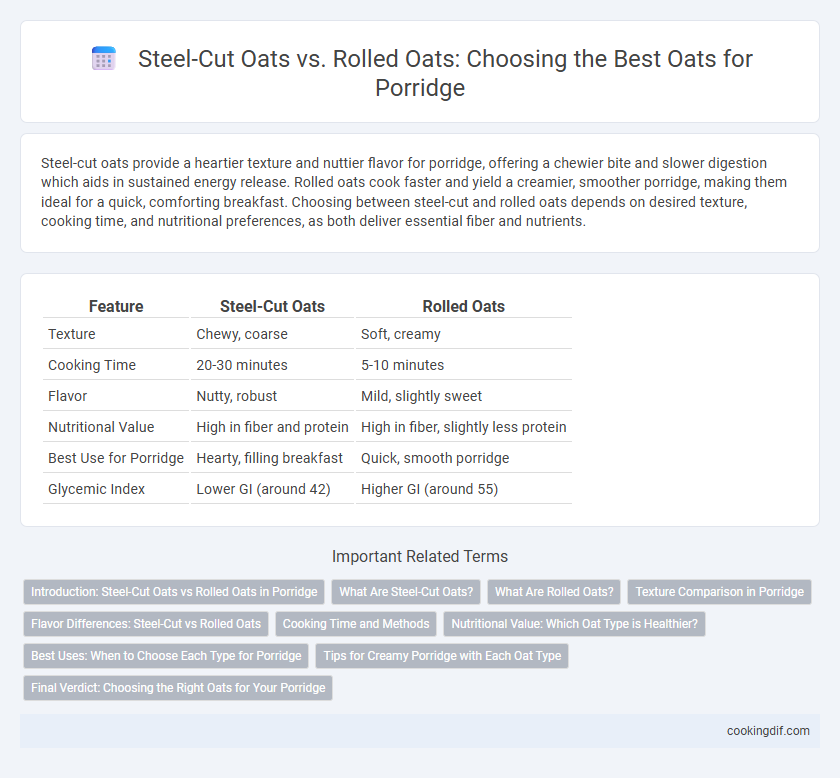Steel-cut oats provide a heartier texture and nuttier flavor for porridge, offering a chewier bite and slower digestion which aids in sustained energy release. Rolled oats cook faster and yield a creamier, smoother porridge, making them ideal for a quick, comforting breakfast. Choosing between steel-cut and rolled oats depends on desired texture, cooking time, and nutritional preferences, as both deliver essential fiber and nutrients.
Table of Comparison
| Feature | Steel-Cut Oats | Rolled Oats |
|---|---|---|
| Texture | Chewy, coarse | Soft, creamy |
| Cooking Time | 20-30 minutes | 5-10 minutes |
| Flavor | Nutty, robust | Mild, slightly sweet |
| Nutritional Value | High in fiber and protein | High in fiber, slightly less protein |
| Best Use for Porridge | Hearty, filling breakfast | Quick, smooth porridge |
| Glycemic Index | Lower GI (around 42) | Higher GI (around 55) |
Introduction: Steel-Cut Oats vs Rolled Oats in Porridge
Steel-cut oats offer a coarser texture and nuttier flavor, ideal for hearty porridge with a chewy bite. Rolled oats provide a smoother consistency and quicker cooking time, making them perfect for creamy, easily digestible porridge. Nutritionally, both oats are rich in fiber, but steel-cut oats have a lower glycemic index, promoting steadier blood sugar levels.
What Are Steel-Cut Oats?
Steel-cut oats are whole oat groats chopped into coarse pieces, offering a chewier texture and nutty flavor compared to rolled oats. They require longer cooking times, typically around 20-30 minutes, making them ideal for a hearty, slow-cooked porridge base. Rich in fiber and protein, steel-cut oats provide sustained energy and a satisfying mouthfeel for breakfast.
What Are Rolled Oats?
Rolled oats are whole oat groats that have been steamed and flattened with large rollers, creating flakes that cook faster than steel-cut oats. Their texture is softer and creamier when cooked, making them ideal for smooth and velvety porridge. Rich in beta-glucan fiber, rolled oats promote heart health and provide sustained energy throughout the morning.
Texture Comparison in Porridge
Steel-cut oats create a chewier, heartier texture in porridge due to their minimal processing and coarse cut, offering a satisfying bite. Rolled oats result in a creamier, smoother porridge consistency as their flattened shape facilitates quicker cooking and a softer mouthfeel. The choice between steel-cut and rolled oats ultimately influences the porridge texture, with steel-cut providing a more substantial, nutty experience versus the velvety softness of rolled oats.
Flavor Differences: Steel-Cut vs Rolled Oats
Steel-cut oats have a nuttier, chewier texture and a more robust, earthy flavor compared to rolled oats, which are milder and creamier when cooked. The coarse texture of steel-cut oats retains more of the oat's natural flavor, providing a heartier porridge experience. Rolled oats absorb liquid more quickly, resulting in a smoother, softer porridge that highlights subtle sweetness rather than the intense oat flavor found in steel-cut varieties.
Cooking Time and Methods
Steel-cut oats require a longer cooking time, typically 20 to 30 minutes, as they consist of whole oat groats cut into pieces, offering a chewier texture and nuttier flavor. Rolled oats cook much faster, usually within 5 to 10 minutes, since they are steamed and flattened, making them ideal for quick porridge preparation. Both methods can utilize stovetop boiling or slow cooking, but steel-cut oats benefit from simmering to soften, while rolled oats absorb liquid swiftly for a creamier consistency.
Nutritional Value: Which Oat Type is Healthier?
Steel-cut oats retain more of the whole grain's bran and germ, resulting in higher fiber content and a lower glycemic index compared to rolled oats. Rolled oats, while slightly more processed, offer similar protein levels but tend to cook faster and may have a marginally higher glycemic response. Choosing steel-cut oats for porridge supports better blood sugar control and increased satiety due to their denser nutritional profile.
Best Uses: When to Choose Each Type for Porridge
Steel-cut oats provide a chewy texture and nutty flavor, making them ideal for hearty, slow-cooked porridge that requires longer cooking times and a robust mouthfeel. Rolled oats absorb liquid more quickly and create a creamier, smoother porridge, perfect for quick breakfasts or recipes requiring a soft consistency. Choosing steel-cut oats suits those prioritizing fiber and a rustic texture, while rolled oats are best for convenience and creamy porridge results.
Tips for Creamy Porridge with Each Oat Type
Steel-cut oats require longer cooking times and more water to achieve a creamy texture; soaking them overnight can soften the grains and reduce cooking time while stirring frequently during cooking helps release starches for creaminess. Rolled oats cook faster and naturally yield a smooth texture without extensive stirring, but using slightly less water than usual and cooking on low heat prevents them from becoming too mushy. For both oat types, finishing with a splash of milk or cream enhances richness and silkiness in the final porridge.
Final Verdict: Choosing the Right Oats for Your Porridge
Steel-cut oats create a chewier texture and nuttier flavor, making them ideal for those who prefer a hearty, rustic porridge. Rolled oats cook faster and yield a creamier consistency, suitable for smooth, comforting bowls. The best choice depends on your desired porridge texture and cooking time, with steel-cut oats favored for robust meals and rolled oats for quick, creamy breakfasts.
Steel-cut oats vs Rolled oats for porridge base Infographic

 cookingdif.com
cookingdif.com